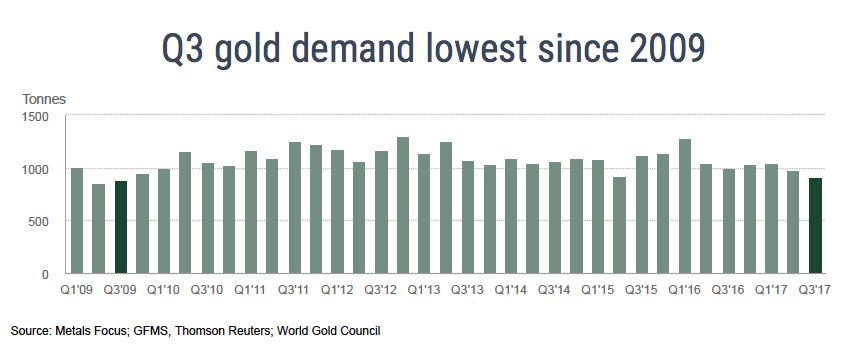
The latest report by The World Gold Council on global trends showed a sharp drop overall demand for the metal during the third quarter as investor purchases of gold-backed exchange traded funds cooled and jewellery demand softened.
Research from WGC, an industry body, indicate global demand fell 9% to 915 tonnes during the September quarter. Year to date demand is down 12%.
Investors continued to pour money into ETFs, but it was more of a trickle
According to the report global jewellery demand was down 3% year-on-year for the three-month period, hurt by a new sales tax and tighter anti-money laundering regulations governing retail jewellery transactions in India, the world’s number one consumer of the metal. Jewellery demand on the subcontinent was down 25% to just shy of 115 tonnes. In contrast US jewellery demand so far in 2017 is at a seven-year high.
Investors continued to pour money into ETFs, but it was more of a trickle – down 87% compared to the 144 tonnes of net inflows into the sector in Q3 2016. Total assets under management grew to 2,343 tonnes valued at $96.7 billion by end-September. Last year saw more than 660 tonnes of inflows into ETFs, the best annual performance since 2009.
Bar and coin investment strengthened by 17% to 222 tonnes, albeit from a low base according to the report.
The WGC said central bank demand stayed robust thanks to continued buying from Russia and Turkey. Net purchases by the official sector jumped 25% year-on-year to 111 tonnes.
Although not a significant source of demand, volumes of gold used in technology increased for the fourth consecutive quarter on the back of strong demand for LEDs and continued growth in the use of 3D sensors in new smartphones which boosted demand by 2% to 84 tonnes.
2016 full year gold demand gained 2% to reach a three-year high of 4,308.7 tonnes.

While gold production at mine level declined by 1% year-on-year in Q3 to 841 tonnes, output so far this year of 2,420 tonnes is the highest on record according to WGC data.
Top producer China, which overtook South Africa a decade ago in terms of gold output – registered its fifth consecutive year on year decline during the quarter. Recently imposed regulations, which target the discharge of cyanide in tailings, continue to bite and may impact production over several more quarters according to the WGC.
The dispute between Acacia Mining and Tanzania’s government again significantly disrupted production in that country, leading to a fall in total Q3 production of 15% year on year, while Burkina Faso also recorded sharply lower production.
In Canada, output rose 10% compared to last year thanks to increases at Brucejack and Hope Bay, both of which started commercial production earlier in the year. Rainy River, NewGold’s mine in northern Ontario, is expected to hit commercial production this month.